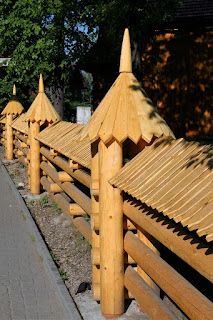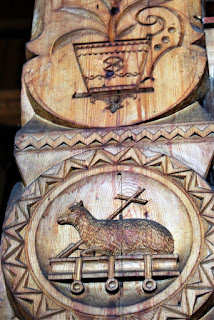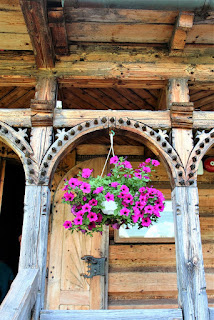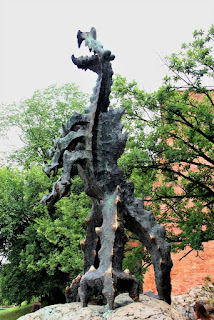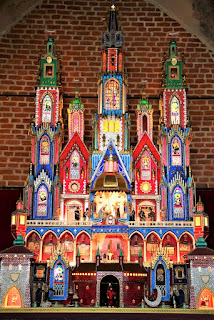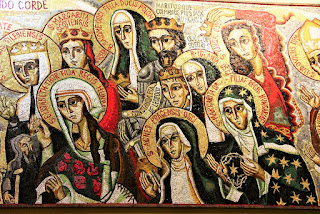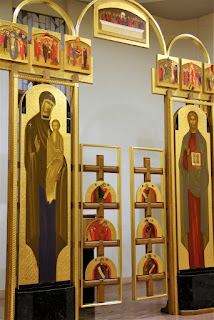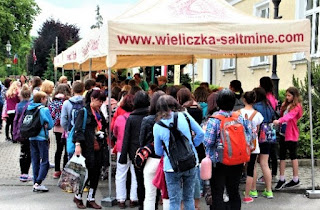Be serious in Poland in 2015
(Travel Story Series @ Hon Too Fang 2021)
Preface
In June 2015 we joined 17 others for a 23-day group tour to Central Europe, setting foot on Austria, Slovakia, Poland and the Czech Republic. The travel story is told in 4 parts. Each of the country would have its story.
Hope you could take the tour with us. It is free. No hidden cost. No advertisement. This story is on Poland. This one is - be serious, like visiting the Auschwitz Prison Camp.
Hon
(28-01-2016)
Poland
Poland is the largest of the 4 countries visited, 313,000 sq km in area (95% of Malaysia) with some 38.5 million people. In ethnicity, 94% Poles. The national language is Polish, a form of Slavic language. In religion, current estimate says Catholics 87%, “no-religion” 2% and “not-to-reveal” 9%. Quite a homogeneous country. The Poles are seriously religious. More churches will be featured. The capital is Warsaw with 1.7 million people.
Poland has the 5th or 6th largest economy in Europe. The economy is led by the service sector and the industry sector. The major industries are automobile and transportation, pharmaceutics and mining. It is in fact the best performing economy of the post-communist countries in Europe.
We visited Zakopane, Krakow, the Wieliczka Salt Mine and the Auschwitz Prison Camp.
Zakopane
Zakopane is a new town at the foot of the Tatra Mountains and near to the border with Slovakia. Population 28,000. Shown delightful scenes of the main street.
The town is also famous for having many timber buildings. It is a ski resort in winter, see the skis in the 2nd photo.
The most impressive structure in town, as is usually the case in Europe, is the parish church, the Church of the Holy Family, about 100 years old as Zakapane is a relatively new town. A well decorated high altar where the center piece is the full carving of the Holy Family.
Old Cemetery
The stone chapel at the Old Cemetery was constructed in 1800, one of the oldest buildings in this new town. The small stone chapel is no more in use, replaced by a bigger timber chapel.
And many of the tombstones in the Old Cemetery are made of timber, maybe they should be called tomb-timber and not tomb-stone.

Flowers in bloom
Wild flowers are blooming everywhere, likely the viola/pansy family, 1st photo and the petunia family, 2nd photo.
Chapel of the Sacred Heart of Jesus
This famous wooden chapel at the outskirt of Zakopane was built between 1904 and 1908, and designed by Stanisław Witkiewicz, the founder of the Zakopane architectural style. The carved wooden altar takes the form of a mountain hut.
Kasprowy Wierch
Kasprowy Wierch is a ski resort 5 km south of Zakopane, in the Polish part of the Tatra Mountains. It is reachable by cable car. The peak is 1,987 m in elevation. Great panoramic views at the top.
Krakow
Krakow is the 2nd largest city in Poland, population: 760,000. It is one of the oldest cities in Poland and was the capital from 1038 to 1596.
The Old Town
The Old Town together with the Wawel Castle is a UNESCO World Heritage site. In fact this is the first old town in the World to be declared by UNESCO as a World Heritage site, in 1978. In 2000, Krakow was named European Capital of Culture.
The Market Square
The Old Town is dominated by the Market Square established in the 12th century. The prominent building here is the Cloth Hall rebuilt in 1555 in the Renaissance style, 1st photo. The tower next to it is the 70 m high Town Hall Tower, 2nd photo, which is the only part remaining of the medieval Town Hall. The next few photos show beautiful facades of the buildings around the square.
Statues and monuments
The Old Town has a profusion of bronze statues and marble monuments. The most famous is the Adam Mickiewicz Monument located at the Market Square. Adam Mickiewicz is the greatest Polish romantic poet of the 19th century. The monument was erected on June 16, 1898 on the 100th anniversary of his birth. Oi, boys, behave yourselves, be serious, don't fool around, this is Poland!
And a few more sculptures, the 1st is the Wawel dragon and then the cheeky Piotr Skrzynecki, a cabaret producer, and lastly, part of a monument to honour Josef Pilsudski, the hero of Polish independence
Wawel Castle
The Wawel Royal Castle and the Wawel Hill constitute two historically and culturally important sites in Poland. The buildings were dated to the 14th century. For centuries it was the residence of the kings of Poland and the symbol of Polish statehood, until the capital was moved to Warsaw in 1596. The Castle is now one of the country’s premier art museum established in 1930. We did not visit the museum.
Churches
Krakow is also known as the city of churches. According to Wikipedia there are over 120 churches as at 2007, half of them relatively new ones constructed in the 20th century. Most are Catholic churches. Weekly mass attendance is near to 50% which is higher than the national average of about 40% and way above other European cities which are mostly below 20%. We visited quite a few churches here.
St Mary Basilica
The impressive St Mary Basilica at the Market Square, founded in 1221 was rebuilt around 1355 to 1365. A brick Gothic church which has become a model for many later churches in the Polish diaspora. The towers are of different heights. The taller north tower was raised in the 15th century to 80 m to be the watch tower for the whole city. The highlight of the interior is the blue, starred ceiling and wooden Gothic altar piece by Veit Stoss from the 15th century incorporating some 200 carved figures, some scenes depicting life in medieval times. Took 12 years to complete. The 4th photo shows the high altar and the last 2 shows carvings in other side chapels.
Church of the Visitation of the Blessed Virgin Mary
The Church of the Visitation of the Blessed Virgin Mary belongs to the Carmelite nuns. The present church was consecrated in 1679, with a Baroque façade. A rather conventional interior, with a huge sculpture depicting the Golgotha scene, where Jesus was crucified flanked by 2 thieves.
Church of St Francis Assisi
The original Church of St Francis Assisi was one of the oldest tall brick-and-sandstone building constructed here, in the 13th century. It went through some rebuilding over the years. After the great fire of 1850, most of the interior were refurbished. Exceptionally colourful interior with big panels of stained glass windows. The most famous stained glass is one called “Our Father in Heaven”, last photo. The 3rd photo shows the elaborate high altar.
The Holy Trinity Church
The Holy Trinity Church was established by the Dominican monks in 1222. The present church was built in the early 15th century. The interior was destroyed in the great fire of 1850 and re-decorated in the neo-Gothic style in 1872. The last 2 photos show the cloister and the Chapel of St Dominic. St Dominic is the founder of the Dominican order of monks.
Pope John Paul II
In Krakow you can’t ignore this name of John Paul II even if you are a Protestant. Born Karol Jozef Wojtyla, the favourite son of Krakow was the Pope of the Catholic Church from 1978 to 2005. He was born in a town called Wadowice, 48 km from Krakow. He studied here in Krakow, was ordained as a priest here in 1946, and served here until 1978, as the cardinal.
Father Wojtyla resided in the apartment at 19 Kanonicza Street from 1951 till 1958, when he was bishop; and at the adjacent No. 21 until 1963, when he was the archbishop. These apartments have become tourist attractions. Big crowds.
Flowers in bloom
It is late spring but many flowers are still in bloom: delphinium, hydrangea, geranium/pelargonium, etc.
Krakow Szopka
Szopka means “nativity scene”. Nativity here means the birth of Jesus Christ. Nativity scene, portraying the infant Jesus in a cot, is a Christian cultures since the 13th century, said to be started by St Francis of Assisi. In Krakow craftsmen started to make nativity scene sets as seasonal decoration since the 19th century. And traditionally they use the famous buildings of Krakow to be the backdrop for the nativity scene. Since 1937, the city council of Krakow conducts a yearly contest near Christmas to choose the most beautiful szopka built.
This one shown is the winner for 2010, on display at a local museum. Like an architectural model. Favourite of the young visitors.
Divine Mercy Sanctuary at Lagiewniki
Divine Mercy is a Catholic devotion to Jesus Christ associated with the reported apparitions of Jesus to the Polish nun St Faustina (1905-1938). It encompasses the endless merciful love of God towards all people. A Divine Mercy Sanctuary was established in a suburb of Krakow called Lagiewniki since 1968. More than 2 million pilgrims come to this shrine each year.
Convent of the Sisters of Our Lady of Mercy
The complex includes the Convent of the Sisters of Our Lady of Mercy, founded in 1862. St Faustina was a nun here. Shown the convent complex. There are many big posters explaining the devotion of Divine Mercy. Shown also votive offerings at a designated room and with the statue of St Faustina.
Divine Mercy Basilica
The 2-storey modern ellipsoidal Basilica was built in 1999 to 2002. Its shape resembles the Art of the Covenant, those whose hearts are filled with hope in the Divine Mercy will find salvation. The simple main church on the upper level could seat 1,800. The simplest high altar has a globe surrounded by shrubs ruffled by strong winds, a metaphor for man struggling with his own weakness and sinfulness. The image of the Divine Mercy by Jan Chrzaszcz is hung above the altar. The last photo was taken at the external wall of the raised platform for the basilica.
The lower level houses 5 individual chapels, including the simple one of St Faustina, 1st photo. Other chapels are more colourful in decoration.
Way of the Cross
The Way of the Cross is located on open field. Shown the 1st of the 14 stations.
Wieliczka Salt Mine
Wieliczka is a Krakow suburb 15 km south-east of the city centre. The mine, built in the 13th century, produced table salt continuously until 2007. Commercial mining was discontinued in 1996 due to low salt prices and mine flooding. The mine reaches a depth of 327 m and the passages total over 287 km long. It is a UNESCO World Heritage Site.
It is one of the most visited tourist attractions in Poland. About 3.5 km of the underground passages is open to the public. At the initial parts of the route, there are exhibits showcasing the history and mining technology. The horse-powered hauling gear in the last photo is dated to the late 18th century. The hauling system in the 3rd photo is even older, introduced here in the 15th century. Of course these were replaced by electrical systems years ago.
The rock salt is naturally grey in various shades, not white or crystalline, 1st photo. Salt statues carved over the years are exhibited, shown here a few on workers in the mine, in typical communist-era styles. And a piece of contemporary art.
The Poles are fiercely religious, many of the carvings are based on Bible stories and religious characters. The statue in the 1st photo is Pope John Paul II and the 2nd photo shows the St Kinga Chapel. St Kinga is the patron saint of miners. The mine is often referred to as the Underground Salt Cathedral of Poland. Even the crystals of the chandeliers shown in the Kinga Chapel are made from rock salt that has been resolved and reconstituted to achieve a clear, glass-like appearance.
Auschwitz Prison Camp
A brief history
On April 27, 1940, the Germans started the construction of a new prison camp near Auschwitz (60 km west of Krakow). The Auschwitz Prison Camp quickly became the largest Nazi concentration and death camp. By the time of its liberation, Auschwitz had grown to include three large camps and 45 sub-camps.
Jews, gypsies, criminals and all those considered undesirable were gathered in Germany and the conquered territories and sent to Auschwitz by train. At the camp, the prisoners were ordered to form 2 lines. Most women, children and the old and weak were sent to the left line for immediate execution. Most young men and strong women were retained as prisoners for hard labour. Execution was by gas poisoning at the gas chambers. Some prisoners were chosen to be experimented upon.
Auschwitz II had 4 main gas chambers, each had its own crematorium. Each gas chamber could kill about 6,000 people a day.
When the Nazis realized that they were losing the war in late 1944, they started destroying evidence of their atrocities at the camp. On January 27, the Russian entered Auschwitz and the camp was liberated.
The exact numbers of casualty are unknown. The estimate is 1.0 to 1.3 million Jews deported to the camp were killed. And at least 100,000 people of other nationalities were killed too.
The Auschwitz Birkenau State Museum
The museum was created by law in 1947, and includes the grounds of Auschwitz I and Auschwitz II camps, covering 191 hectares. We visited only the Auschwitz I camp. On the museum grounds stand several hundred buildings and ruins, including ruins of the gas chambers and crematoria. It is a UNESCO World Heritage Site.
Shown fencing, camp buildings and the main entrance, 1st photo, with the overhead signage "Work Set You Free". A slogan to mislead the prisoners. The 2nd photo shows a sentry post for roll calls, etc.
Exhibits in the museum include shoes, bags and artificial limbs once belonged to the victims, and many old photos. The museum holds more than 100,000 pairs of shoes.
Shown here are an old fright car to transport prisoners, a bunk bed for the prisoners retained as slave workers, set-up of a reconstructed gas-chamber and the ruins of the only crematorium in Auschwitz I.
And lastly the Auschwitz II Gatehouse leading to the bigger Auschwitz II camp where in later stage all the gassing and cremation took place.
--- And on that solemn note, we end our story of “Be Serious in Poland” ---
Note: the tour promoter is Yongo Travel (www.yongo.biz) led by Rachel
(First written in January 2016 in the email format. Lightly revised to this PDF format in October 2021)








